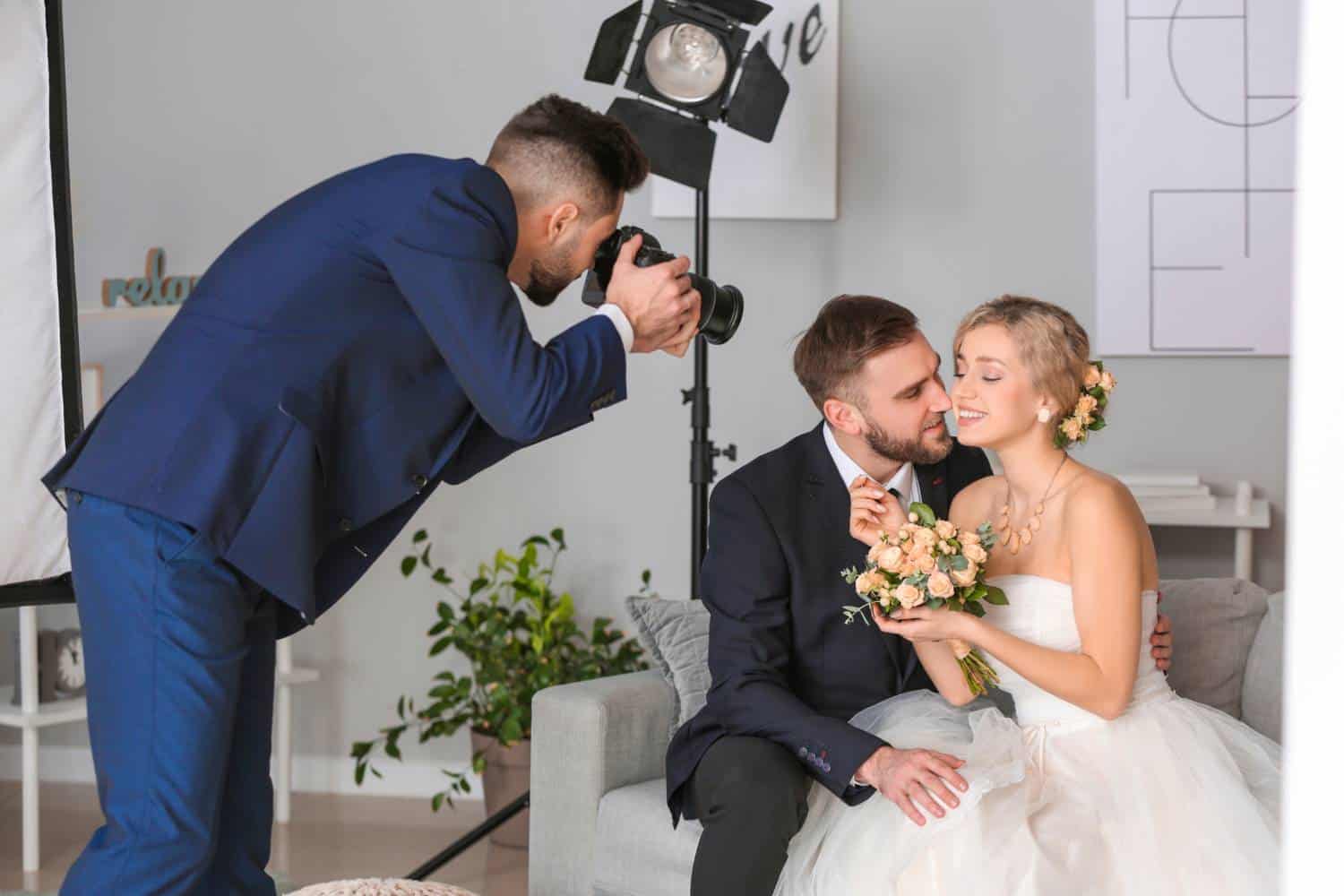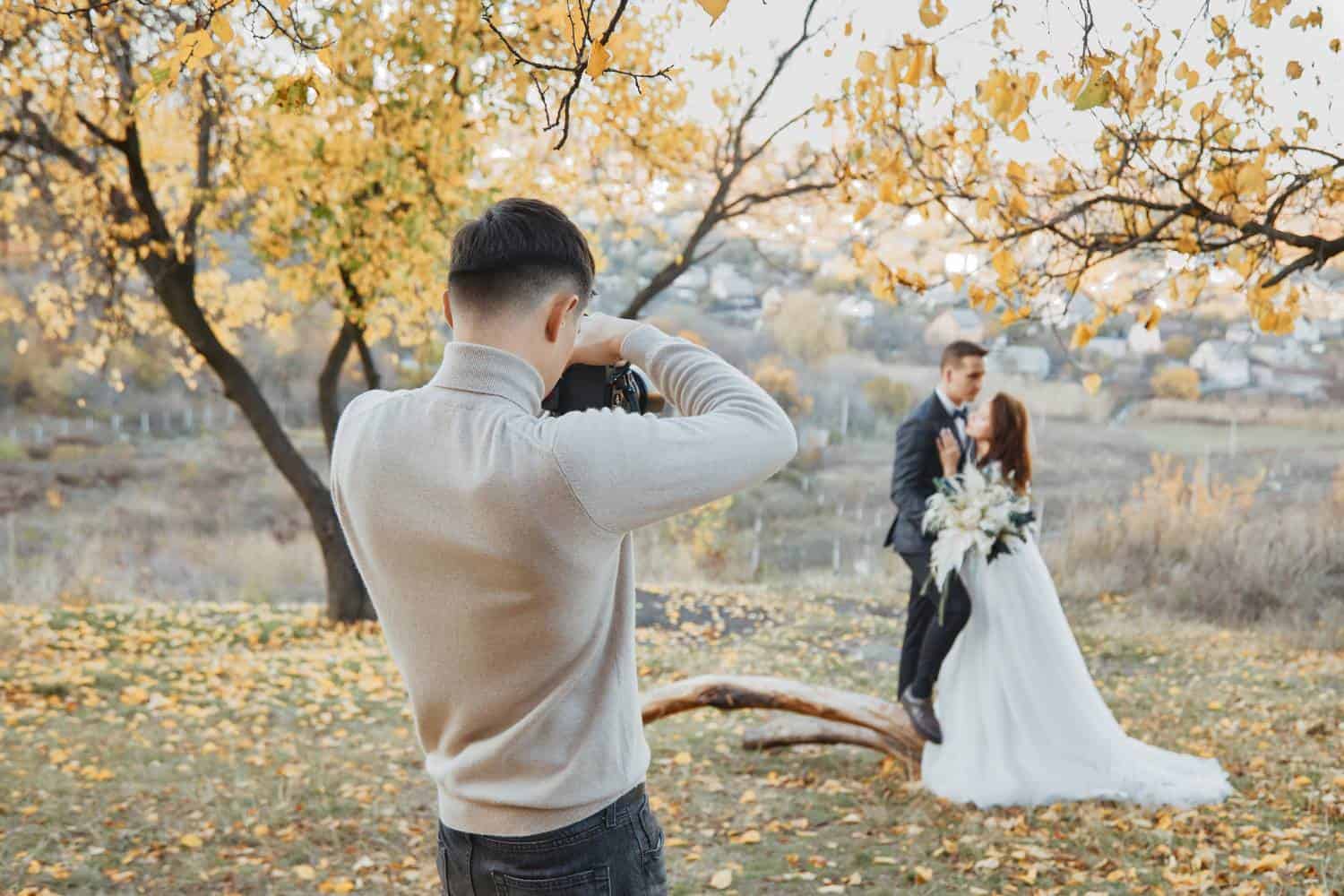Preparation is key to capturing the important moments when photographing your first wedding.
From understanding the couple’s schedule to scouting the venue, every detail ensures a smooth experience.
Equally important is being ready for changing lighting conditions, keeping calm, and blending into the background to capture candid moments.
Let’s get straight to the point.
To shoot a wedding successfully as a beginner, start by understanding the schedule and key moments, such as the ceremony and speeches, and capture them on time.
Visiting the venue in advance helps you plan your shots and understand lighting conditions.
Properly prepare your gear, including having backup equipment, and be ready to adapt to changing lights throughout the day.
How To Shoot A Wedding For Beginners
Understand The Schedule
The first step to successful wedding photography is knowing the schedule. Discuss the day’s timeline with the couple in advance.
Knowing when important events like the ceremony, speeches, and first dance will happen helps ensure you’re in the right place at the right time.
Missing a key moment because of poor planning can disappoint you and the couple.
Additionally, ask if there are specific moments they want to be captured. These could include unique family traditions, important guests, or sentimental details like a special piece of jewellery.
Understanding these priorities ensures you capture the memories they value most.
Visit The Venue In Advance
It’s helpful to visit the venue ahead of time. Familiarising yourself with the space allows you to plan your shots and choose the best locations for portraits and group photos.
Pay attention to lighting conditions, as these can change throughout the day. Knowing where the light falls at different times helps you position your subjects effectively.
If you can’t visit the venue in person, try researching it online. Photos of the location will give you an idea of potential shooting spots and help you prepare for challenges like tight spaces or dim lighting.
Prepare Your Gear
Having the right equipment is essential. Ideally, bring two camera bodies: one with a wide-angle lens for group shots and venue details and one with a longer lens for close-ups.
This setup lets you quickly switch between shots without wasting time changing lenses.
Always carry extra batteries, memory cards, and a backup camera. Weddings are long events, and running out of power or storage can disrupt your workflow.
Consider using a tripod or monopod for long ceremonies, and bring a flash or reflector for low-light situations. Being prepared ensures you won’t miss any important moments due to technical issues.
Adapt To Changing Light Conditions
Light can change dramatically during a wedding, especially for outdoor ceremonies. Adjusting quickly to different lighting conditions is essential for capturing high-quality images.
Soft morning light can provide beautiful, natural tones, while midday sun can cast harsh shadows. Be ready to adapt your camera settings to make the most of each situation.
For indoor shots, you may need to rely on artificial lighting. Bouncing light off ceilings or walls can soften the effect and create a more natural look.
Avoid using direct flash on the subjects unless necessary, as it can make images appear too harsh.
Capture Candid Moments
While posed shots are important, candid photos often capture the true essence of a wedding.
Look for natural, emotional moments—tears during the vows, laughter during the speeches, or a shared glance between the couple. These are the moments that will truly reflect the day’s emotions.
Blend into the background to avoid interrupting these moments. A longer lens can help you capture candid shots without being intrusive.
Couples often value these spontaneous images more than the staged ones, as they highlight the day’s genuine emotions.
Be Ready For Action Shots
Weddings are full of movement—from the first dance to the bouquet toss. To avoid motion blur, it’s important to use a fast shutter speed for these moments.
Using burst mode can help capture a series of shots quickly, ensuring you don’t miss the perfect moment during fast-moving events.
Practice capturing motion beforehand, as these moments are often unpredictable.
Whether it’s children playing, guests dancing, or a spontaneous moment of joy, being ready to photograph action will add energy to your final collection.
Give Space When Needed
It’s tempting to try and capture every moment, but sometimes it’s best to step back. During private moments, such as a couple’s quiet time together, be respectful and give them space.
You can still capture the moment from a distance if necessary, but avoid intruding on their time.
Overcrowding the couple or guests can lead to frustration, so it’s important to maintain a balance between being present and giving space. Pacing yourself also ensures you stay focused and alert throughout the day.
Build Confidence Through Practice
Confidence comes with experience. Before the wedding, attend rehearsals or practice at other events to familiarise yourself with your camera and shooting techniques.
This will help you become quicker at adjusting settings and more comfortable in high-pressure situations.
Additionally, study the work of other wedding photographers to gather inspiration.
Please pay attention to how they frame their shots, use light, and capture emotions. Learning from others will help you develop your style and overall photography skills.
Focus On The Details
Details can make a wedding album stand out. Take close-up shots of the bouquet, rings, shoes, and table settings.
Couples spend a lot of time choosing these details, and they’ll appreciate having photos that capture the smaller aspects of their day.
A macro lens is useful for getting sharp, detailed shots. Experiment with different angles to make the most of these details.
These images help complete the wedding story and highlight the couple’s attention to the finer touches.
Stay Calm Under Pressure
Weddings can be unpredictable. Weather changes, timelines get delayed, and unexpected challenges arise.
As a photographer, it’s important to stay calm and adaptable. When things don’t go as planned, keep a positive attitude and find ways to work around the issue.
Having a backup plan for various situations—like shooting indoors if rain interrupts an outdoor ceremony—can help you stay prepared.
Couples will appreciate your professionalism, and you’ll be able to deliver great photos regardless of the circumstances.
Edit Thoughtfully
Editing is an essential part of the process. Adjustments like exposure, contrast, and colour balance can significantly enhance your photos.
However, be careful to budget. Most couples prefer natural-looking images that reflect the true atmosphere of their wedding day.
Using editing software like Adobe Lightroom allows you to maintain a consistent look across all the photos.
Apply the same style throughout the album, but don’t be afraid to experiment with a few different looks to see what works best for the specific event.
Build Your Portfolio
Each wedding you shoot is an opportunity to build your portfolio. You may need to take on smaller weddings early to gain experience.
Use these events to improve your skills and create a diverse photo collection that showcases your abilities.
A strong portfolio helps you attract future clients. Include various images, such as candid moments, posed portraits, and detailed close-ups.
Showcasing your versatility as a photographer will demonstrate your capability to handle different aspects of wedding photography.
Reflect And Learn
After each wedding, review your photos and reflect on your performance. Look for areas where you can improve, such as timing, composition, or technique.
Learning from each event helps you grow as a photographer and become more skilled at handling different situations.
You can also join online photography communities or attend workshops to gain feedback and insights from other professionals. L
earning from others’ experiences will help you avoid common mistakes and refine your approach.
Collaborate With Other Vendors
Building good relationships with other wedding vendors, such as the planner, florist, and caterer, can make your job easier. When vendors work well together, the entire event runs more smoothly.
For instance, a wedding planner can alert you to important moments, while a florist may provide input on how best to photograph their arrangements.
Additionally, these relationships can lead to future opportunities. Vendors may recommend you to other clients, helping you expand your network and grow your business as a wedding photographer.
Maintain Professionalism
Throughout the wedding day, it’s important to remain professional. Dress appropriately, be polite, and stay focused on the job.
Weddings can be long and demanding, but maintaining a positive attitude will leave a good impression on the couple and their guests.
After the event, deliver the photos on time and communicate clearly with the couple about the editing process.
Being organised and reliable ensures a smooth experience from start to finish, which can lead to positive reviews and referrals for future work.
Manage Time Effectively
Time management is important during a wedding. Arrive early to capture the preparations and set up your equipment.
Leave enough time between events to move between locations and adjust your settings. Staying organised will help you capture all the important moments without feeling rushed.
Monitor the timeline and coordinate with the couple to ensure you’re ready for key events. Being punctual and efficient throughout the day will help you deliver a complete and cohesive wedding album.
Build Relationships With Guests
While the couple is the main focus, guests play a significant role in the day’s story.
Make sure to capture group shots of family and friends and candid moments of them enjoying the celebration. These photos add a personal touch and show the joy shared by everyone involved.
Guests appreciate these images, and they often help round out the couple’s memory of the day. Don’t forget to focus on these moments during the reception when everyone is more relaxed and having fun.
Conclusion
Shooting a wedding as a beginner may feel daunting, but with proper preparation and the right mindset, you can deliver beautiful, meaningful photos.
Understanding the schedule, preparing your gear, and adapting to changing conditions will help you navigate the day smoothly.
By focusing on the big moments and the small details, you’ll create a wedding album that the couple will cherish for years.
As you gain experience, your skills and confidence will continue to grow, making each wedding shoot a rewarding and successful experience.
Frequently Asked Questions
What mode should I shoot in for a wedding?
Both Shutter Priority Mode and Aperture Priority Mode have their downfalls, which is why it’s best to shoot your wedding photography on Manual Mode. Manual Mode allows you to set each camera value, which leaves nothing up to chance.
What is the difference between pre wedding shoot and post wedding shoot?
A pre wedding shoot is not an engagement session. Its a portrait session where the couple get dressed in their wedding atire and do their wedding portraits before the day. A post wedding session is not a trash the dress (unless they want to trash their dress!)
Can you take wedding photos anywhere?
Photography rights at your wedding ceremony or reception venue. Wedding venue hire usually includes the rights to have your wedding photography on site. It’s worth checking with your church or registry office if there are any other weddings on that day.
What is the best shutter speed for wedding photography?
For weddings and hand-holding images, we’d recommend a shutter speed of 1/100th of a second or faster. A slower shutter speed is quite the opposite. With a slower shutter speed, you’re allowing your camera’s shutter to open and close at a slower rate. Which may or may not introduce motion blur.
What is meant by pre wedding shoot?
A pre-wedding shoot takes place any time before a couple’s wedding date-even the day before! These sessions are not focused on ring shots, proposal recreations, or getting a picture for a newspaper announcement.



